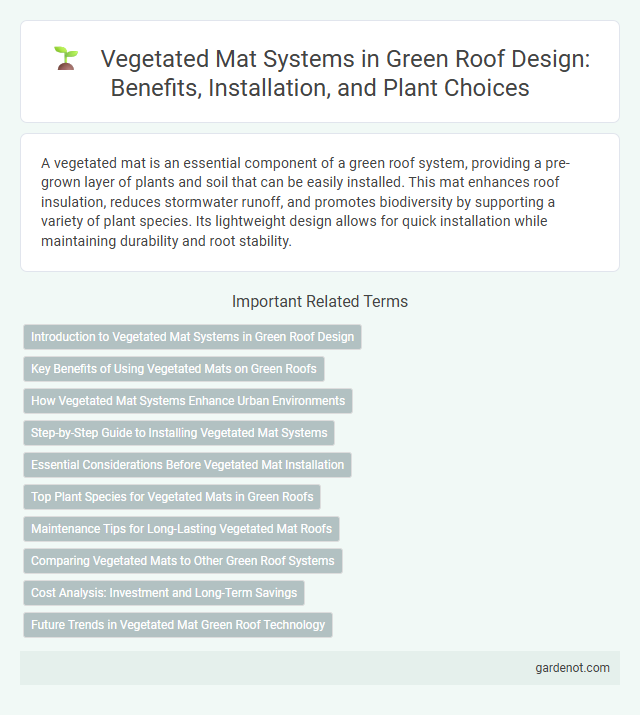A vegetated mat is an essential component of a green roof system, providing a pre-grown layer of plants and soil that can be easily installed. This mat enhances roof insulation, reduces stormwater runoff, and promotes biodiversity by supporting a variety of plant species. Its lightweight design allows for quick installation while maintaining durability and root stability.
Introduction to Vegetated Mat Systems in Green Roof Design
Vegetated mat systems in green roof design consist of pre-grown plant layers rooted in a soil medium, allowing for quick installation and immediate vegetation coverage. These mats are engineered to improve stormwater management, enhance thermal insulation, and promote biodiversity in urban environments. Using native plant species within vegetated mats supports habitat creation while reducing maintenance and irrigation needs.
Key Benefits of Using Vegetated Mats on Green Roofs
Vegetated mats on green roofs provide immediate ground cover, reducing soil erosion and enhancing water retention to manage stormwater effectively. These mats improve thermal insulation, lowering building energy consumption by stabilizing rooftop temperatures. Their low maintenance and rapid vegetation establishment contribute to increased biodiversity and overall rooftop ecosystem health.
How Vegetated Mat Systems Enhance Urban Environments
Vegetated mat systems enhance urban environments by providing immediate green coverage, reducing heat island effects, and improving air quality through natural filtration of pollutants. These systems support biodiversity by creating habitats for insects and birds while managing stormwater runoff to decrease urban flooding risks. Their modular design allows for easy installation on rooftops, increasing green spaces and promoting sustainable urban development.
Step-by-Step Guide to Installing Vegetated Mat Systems
Installing vegetated mat systems begins with preparing a structurally sound roof deck and applying a waterproof membrane to prevent water infiltration. Next, lay the drainage layer followed by the root barrier to protect the building from root penetration. Finally, roll out the pre-vegetated mats evenly over the substrate, ensuring proper irrigation and maintenance for optimal vegetation establishment and growth.
Essential Considerations Before Vegetated Mat Installation
Selecting the appropriate vegetated mat for green roofs requires evaluating factors such as local climate conditions, plant species compatibility, and substrate composition to ensure optimal growth and water retention. Proper assessment of the mat's thickness, drainage capacity, and root structure promotes longevity and prevents structural damage. Ensuring compatibility with existing roofing materials and verifying load-bearing limits are crucial steps before installation to maintain roof integrity and sustainability.
Top Plant Species for Vegetated Mats in Green Roofs
Sedum species dominate as the top plant choice for vegetated mats in green roofs due to their drought tolerance and shallow root systems. Other popular species include native grasses and wildflowers such as Festuca and Achillea, which enhance biodiversity and resilience. These plants collectively optimize water retention, reduce urban heat island effects, and increase green roof longevity.
Maintenance Tips for Long-Lasting Vegetated Mat Roofs
Regular inspection and removal of debris prevent root obstruction and enhance water drainage on vegetated mat roofs. Periodic watering during dry spells ensures optimal plant health and prevents mat drying. Applying slow-release fertilizers and trimming overgrown vegetation helps maintain dense, healthy coverage and prolongs mat lifespan.
Comparing Vegetated Mats to Other Green Roof Systems
Vegetated mats offer a lightweight, pre-grown planting medium that enables faster installation and immediate coverage compared to traditional green roof systems like extensive or intensive roofs. These mats provide uniform plant establishment, reduce soil erosion risk, and enhance water retention efficiency, outperforming modular trays that may have gaps or inconsistent plant density. Their thin profile and integrated root zone make vegetated mats ideal for retrofitting buildings with weight limits while maintaining effective thermal insulation and stormwater management.
Cost Analysis: Investment and Long-Term Savings
Vegetated mats for green roofs offer a cost-effective solution with lower initial investment compared to extensive green roofing systems, typically ranging from $10 to $25 per square foot. Long-term savings arise from reduced energy costs due to enhanced insulation properties, potentially cutting cooling and heating expenses by up to 20%. Maintenance costs remain minimal, as vegetated mats require less irrigation and soil replacement, contributing to overall lifecycle cost efficiency.
Future Trends in Vegetated Mat Green Roof Technology
Vegetated mat green roof technology is advancing with innovations in lightweight, drought-resistant materials that enhance plant survival and reduce maintenance needs. Integration of smart irrigation systems and sensor-based moisture monitoring is improving water efficiency and overall sustainability. Future trends also include biodegradable mat components to minimize environmental impact and promote easier installation and removal.
Vegetated mat Infographic

 gardenot.com
gardenot.com